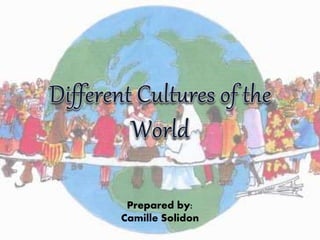
What is Culture? Defining and Transmitting Cultural Traits
- 3. •Culture is defined as the set of learned behaviors, beliefs, attitudes, values, and ideals that are characteristics of a particular society or population (Ember, 1999). •Culture should be regarded as “the set of distinctive spiritual, material, intellectual, and emotional features of society or a social group, and that it encompasses, in addition to art and literature, lifestyles, ways of living together, value systems, traditions and beliefs.” (UNESCO, 2002)
- 4. • Culture is learned • Culture is shared by a group of people • Culture is cumulative • Cultures change • Culture is dynamic • Culture is ideational • Culture is diverse • Culture gives us a range of permissible behavior patterns
- 5. COMMUNICATION COGNITIVE BEHAVIORAL MATERIAL Language Symbols Ideas Knowledge Beliefs Values Accounts Norms • Mores • Laws • Folkways • Rituals Tools, Medicines Books Transportation Technologies
- 7. 1. Ideas/Knowledge/Beliefs- Ideas are mental representations used to organize stimulus. Knowledge is the storehouse where we accumulate representations, information, facts, assumptions, etc. Beliefs accept a proposition, statement, description of fact as true. 2. Values- they support beliefs, or specific statements that people hold to be true.
- 8. 3. Accounts- are how people use that common language to explain, justify, rationalize, excuse, or legitimize our behavior to themselves and others.
- 9. 1. Norms- are rules and expectations by which a society guides the behavior of its members. • Mores: customary behavior patterns or folkways which have been taken on a moralistic value. • Laws: the most formal and important norms. • Folkways: behavior patterns of society which are organize and repetitive. • Rituals: highly scripted ceremonies or strips of interaction that follow a specific sequence of actions.
- 11. THE ORGANIZATION OF CULTURE TRAITS Is either a material or non-material culture, represents a single element or a combination of elements related to a specific situation. Example. Kissing the hands of the elders after Sunday mass and at Angelus.
- 12. How is Culture Transmitted 1. Enculturation 2. Acculturation 3. Assimilation
- 13. Enculturation • It is the process of learning culture of one’s own group Ex. learning the language, folkways and social traditions.
- 14. Acculturation • It is the process of learning some new traits from another culture Ex. Migrating from a rural area to urban area and learning the custom of the new place
- 15. Assimilation • It is the process in which an individual entirely loses its awareness of his/her previous group identity and takes on the culture and attitudes of another group. Ex. An American speaks only Waray-waray and assumes the folkways, etc. of the local group.
- 16. Importance and Functions of Culture 1. Culture helps the individual fulfill his potential as a human being. 2. Through the development of culture man can overcome his physical disadvantages and allows us to provide ourselves with fire, clothing, food and shelter.
- 17. 3. Culture provides rules of proper conduct for living in a society. 4. Culture also provides the individual concepts of family, nation, and class.
- 18. “Culture is necessary for a healthy society.”
- 22. Dragon Dance of the Chinese Culture
- 24. Irish Culture: Leprechaun and a shamrock
- 25. Korean Cultural New Year’s
- 26. Spanish Culture: Dia de los Muertos
- 29. Japanese Culture: Kimono dress
- 31. Hippie Culture: Peace symbol